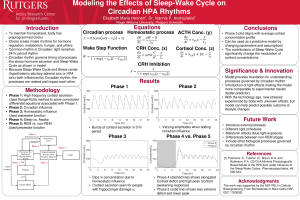Hennen, Elizabeth: Modeling the Effects of Sleep-Wake Cycle on Circadian HPA Rhythms
Title: Modeling the Effects of Sleep-Wake Cycle on Circadian HPA Rhythms
Name: Elizabeth Hennen
Home Institute: Roger Williams University
Programs: RISE program, REU – Cellular Bioengineering
Other contributors: Ioannis P. Androulakis
Abstract: The circadian timing system is comprised of an intricate network of time-keeping clocks distributed across our body. Their responsibility is to allocate resources and distribute functions temporally to optimize fitness. The molecular structures generating these rhythms have evolved to accommodate the rotation of the earth to, primarily, match the light and dark periods during the 24-hour day. To maintain synchrony of timing across and within tissues, information from the central clock, located in the suprachiasmatic nucleus (SCN), is conveyed using systemic signals. Leading among those signals are endocrine hormones released by the hypothalamic-pituitary-adrenal (HPA) axis. The rhythmic, also known as circadian, cortisol release from the HPA axis is a major entrainer of human physiology by maintaining homeostasis and health. The innate modulations of the HPA axis is largely governed by the sleep-wake cycles: both directly and indirectly. Therefore, if one’s sleep patterns are disturbed, cortisol release will be as well. Unfortunately, modern societies have made living under irregular sleep patterns (shift work, chronic or social jetlag) an essential component of daily life. Approximately 30% of the US population who serve our communities do so by working in occupations that require night work like healthcare professionals, law enforcement, transportation, and many more occupations. This does not include the effects of modern technological advancements.
The purpose of our studies was to implement and test a physiologically based mathematical model of the HPA under the effects of the sleep-wake cycle. Such models enable us to better understand the relationship between the release of stress hormones (cortisol) and sleep. Understanding how circadian desynchronization of the HPA axis, driven by irregular or abnormal sleep patterns and other lifestyle-related disruptions, leads to disease and what factors contribute to personalized tolerance to circadian disruption is a critical question.
Biography: Elizabeth Hennen is from Bristol, Rhode Island and is a Biomedical Engineering major at Roger Williams University (RWU) with a minor in mathematics. She will be a senior in the fall. She is a member of IEEE and SWE and works as a mathematics and engineering tutor. This summer, Elizabeth worked in Dr. Ioannis Androulakis’s lab modeling the sleep-wake cycle’s effects on stress hormone secretion. Elizabeth plans to pursue a Ph. D in Biomedical Engineering after completing her bachelor’s degree.
